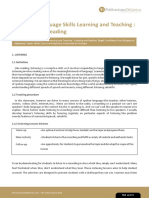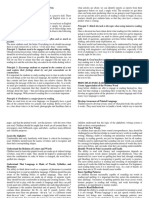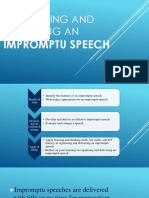0 ratings0% found this document useful (0 votes)
48 viewsArticle 1 Principles in Teaching Reading
Article 1 Principles in Teaching Reading
Uploaded by
Janella NuquiThe document outlines six main principles for teaching reading:
1. Encourage students to read as often and as much as possible outside of class.
2. Engage students with the topics they are reading about and allow them to respond to and explore their feelings about the content.
3. Use prediction to help students anticipate what they will read, and give clues to set expectations before reading begins.
Copyright:
© All Rights Reserved
Available Formats
Download as PDF, TXT or read online from Scribd
Article 1 Principles in Teaching Reading
Article 1 Principles in Teaching Reading
Uploaded by
Janella Nuqui0 ratings0% found this document useful (0 votes)
48 views2 pagesThe document outlines six main principles for teaching reading:
1. Encourage students to read as often and as much as possible outside of class.
2. Engage students with the topics they are reading about and allow them to respond to and explore their feelings about the content.
3. Use prediction to help students anticipate what they will read, and give clues to set expectations before reading begins.
Copyright
© © All Rights Reserved
Available Formats
PDF, TXT or read online from Scribd
Share this document
Did you find this document useful?
Is this content inappropriate?
The document outlines six main principles for teaching reading:
1. Encourage students to read as often and as much as possible outside of class.
2. Engage students with the topics they are reading about and allow them to respond to and explore their feelings about the content.
3. Use prediction to help students anticipate what they will read, and give clues to set expectations before reading begins.
Copyright:
© All Rights Reserved
Available Formats
Download as PDF, TXT or read online from Scribd
Download as pdf or txt
0 ratings0% found this document useful (0 votes)
48 views2 pagesArticle 1 Principles in Teaching Reading
Article 1 Principles in Teaching Reading
Uploaded by
Janella NuquiThe document outlines six main principles for teaching reading:
1. Encourage students to read as often and as much as possible outside of class.
2. Engage students with the topics they are reading about and allow them to respond to and explore their feelings about the content.
3. Use prediction to help students anticipate what they will read, and give clues to set expectations before reading begins.
Copyright:
© All Rights Reserved
Available Formats
Download as PDF, TXT or read online from Scribd
Download as pdf or txt
You are on page 1of 2
MAIN PRINCIPLES OF TEACHING READING
Liudmyla Voinalovych (Zhytomyr, Ukraine)
Reading is a receptive language activity, but not a passive skill. There are many
reasons why getting students to read English texts is an important part of the teacher's job.
In the first place, many students want to be able to read texts in English either for their
careers, for study purposes or simply for pleasure. Anything we can do to make it easier
for them to do these things must be a good idea. While teaching reading we should
observe the following principles.
Principle 1: Encourage students to read as often and as much as possible.
The more students read, the better. Everything we do should encourage them to read
extensively as well as – if not more than – intensively.
Principle 2: Students need to be engaged with what they are reading.
Outside normal lesson time, when students are reading extensively, they should be
involved in joyful reading – that is, we should try to help them get as much pleasure from
it as possible. But during lessons, too, we will do our best to ensure that they are engaged
with the topic of a reading text and the activities they are asked to do while dealing with it.
Principle 3: Encourage students to respond to the content of a text (and explore
their feelings about it), not just concentrate on its construction.
It is important for students to study reading texts in class in order to find out such
things as the way they use language, the number of paragraphs they contain and how many
times they use relative clauses. But the meaning, the message of the text, is just as
important as this. As a result, we must give students a chance to respond to that message in
some way. It is especially important that they should be allowed to show their feelings
about the topic – thus provoking personal engagement with it and the language. With
extensive reading this is even more important.
Principle 4: Prediction is a major factor in reading.
When we read texts in our own language, we frequently have a good idea of the
content before we actually start reading. Book covers give us a clue about what is in the
book; photographs and headlines hint at what articles are about; we can identify reports as
reports from their appearance before we read a single word. The moment we get these
clues our brain starts predicting what we are going to read. Expectations are set up and the
active process of reading is ready to begin. In class, teachers should give students hints so
that they also have a chance to predict what is coming.
Principle 5: Match the task to the topic when using intensive reading texts.
Once a decision has been taken about what reading text the students are going to
read (based on their level, the topic of the text and its linguistic and activation potential),
we need to choose good reading tasks – the right kind of questions, appropriate activities
before during and after reading, and useful study exploitation, etc.
The most useful and interesting text can be undermined by boring and inappropriate
tasks; the most commonplace passage can be made really exciting with imaginative and
challenging activities, especially if the level of challenge (i.e. how easy it is for students to
complete a task) is exactly right for the class.
Principle 6: Good teachers exploit reading texts to the full.
Any reading text is full of sentences, words, ideas, descriptions, etc. It doesn't make
sense, in class, just to get students to read it and then drop it and move on to something
else. Good teachers integrate the reading text into interesting lesson sequences, using the
topic for discussion and further tasks, using the language for study and then activation (or,
of course, activation and then study) and using a range of activities to bring the text to life.
References
1. Ніколаєва С. Ю. Методика навчання іноземних мов у середніх навчальних
закладах. Підручник. – К.: Ленвіт, 1999. – 320 с.
2. Jeremy Harmer. How to teach English. Pearson Education Limited, 2007. – 288 p.
You might also like
- Fifty Ways to Teach Reading: Fifty Ways to Teach: Tips for ESL/EFL TeachersFrom EverandFifty Ways to Teach Reading: Fifty Ways to Teach: Tips for ESL/EFL TeachersRating: 4 out of 5 stars4/5 (3)
- Oral Communication DLLDocument3 pagesOral Communication DLLJanella Nuqui67% (3)
- MELC Grade 7 - 10 EnglishDocument7 pagesMELC Grade 7 - 10 EnglishJanella Nuqui78% (9)
- SHS 2nd Quarter Exam PE1Document4 pagesSHS 2nd Quarter Exam PE1Janella Nuqui100% (10)
- Teaching ReadingDocument22 pagesTeaching Readingaidosh0807No ratings yet
- Teaching ReadingDocument11 pagesTeaching ReadingVen KeraNo ratings yet
- Methodology ExamDocument113 pagesMethodology ExamLeyla AliyevaNo ratings yet
- Isi Bab 1-3Document43 pagesIsi Bab 1-3Nur Hidayah Pauzi HarahapNo ratings yet
- Training For DeltaDocument4 pagesTraining For DeltaViyal CorNo ratings yet
- The Importance of ReadingDocument39 pagesThe Importance of ReadingyousufbaiNo ratings yet
- Reading Activities For Intermediate StageDocument26 pagesReading Activities For Intermediate StageLiliya BulatovaNo ratings yet
- Main Principles of Teaching ReadingDocument2 pagesMain Principles of Teaching Readingmicas carilloNo ratings yet
- TEFL How To Leach ReadingDocument7 pagesTEFL How To Leach Readingsilva.angraini26No ratings yet
- Teaching ProseDocument6 pagesTeaching ProseLovely VinishNo ratings yet
- INTRODUCTIONDocument12 pagesINTRODUCTIONAstenaLargamaNo ratings yet
- Teaching ReadingDocument34 pagesTeaching ReadingАрайлым ЕлеусізоваNo ratings yet
- A New Teaching Strategy For ReadingDocument10 pagesA New Teaching Strategy For ReadingSavira Ramadhani100% (1)
- Teaching ReadingDocument14 pagesTeaching Readingangelito pera100% (1)
- Summary Chapter 9Document2 pagesSummary Chapter 9Owi BenningtonNo ratings yet
- Skripsi Pre-TeachingDocument6 pagesSkripsi Pre-TeachingJoehart BhuntdalNo ratings yet
- 10 Principles For ReadingDocument18 pages10 Principles For ReadingBrenda Lara RuizNo ratings yet
- Investigation PrepositionsDocument9 pagesInvestigation Prepositionsstephany pachecoNo ratings yet
- 195d140231034 ELT303Document7 pages195d140231034 ELT303Thu HIềnNo ratings yet
- Understand Language Skills READING AND WRITINGDocument11 pagesUnderstand Language Skills READING AND WRITINGSunil SagarNo ratings yet
- CH 8 - SelectedDocument9 pagesCH 8 - SelectedAli QuasimNo ratings yet
- Extensive ReadingDocument8 pagesExtensive ReadingRia WiniamsyahNo ratings yet
- Theories of Language Learning and TeahingDocument7 pagesTheories of Language Learning and TeahingMiro MiroNo ratings yet
- Teacihng EFL ESL Reading, TBLTDocument13 pagesTeacihng EFL ESL Reading, TBLTabcdxyzNo ratings yet
- Teaching Reading: Strategies For Dealing With A TextDocument2 pagesTeaching Reading: Strategies For Dealing With A TextRaluca FloreaNo ratings yet
- Teaching ReadingDocument12 pagesTeaching ReadingDado Dodo100% (1)
- Teaching Method - Reading Approach 2Document8 pagesTeaching Method - Reading Approach 2djoiajgNo ratings yet
- ENGLISH TEACHING PLANNING Fitri Handayani 18.1300.039 - WPS Office 2Document4 pagesENGLISH TEACHING PLANNING Fitri Handayani 18.1300.039 - WPS Office 2Fitri handayaniNo ratings yet
- Mid-Term Exam Assignment 1 (25 Points) : (Please Write Your Answer Below and Submit This Document)Document5 pagesMid-Term Exam Assignment 1 (25 Points) : (Please Write Your Answer Below and Submit This Document)Tuba ArvasNo ratings yet
- SPEC ReportDocument34 pagesSPEC ReportAbegail Dela CruzNo ratings yet
- Learn and Grow: Writing TeamDocument70 pagesLearn and Grow: Writing TeamleilaNo ratings yet
- Receptive Language Skills Learning and Teaching: Listening and ReadingDocument4 pagesReceptive Language Skills Learning and Teaching: Listening and Readingericabalan94No ratings yet
- Reading Intesive and ExtensiveDocument11 pagesReading Intesive and ExtensiveSuciati Anandes100% (1)
- RR FileDocument40 pagesRR Filehimanshisorot04No ratings yet
- Extensive Reading TrueDocument9 pagesExtensive Reading TrueMarni HuluNo ratings yet
- Topic 4 Stages of A Reading Comprehensions Lesson & Stages of A Literacy HourDocument14 pagesTopic 4 Stages of A Reading Comprehensions Lesson & Stages of A Literacy HourWan Amir Iskandar IsmadiNo ratings yet
- A ReviewDocument4 pagesA ReviewNOR ELITA BINTI MD RADZI MoeNo ratings yet
- Interactive Post-Reading Activities That Work: Arwijati WahjudiDocument9 pagesInteractive Post-Reading Activities That Work: Arwijati WahjudiNURULNo ratings yet
- Paper Reading (Group 4)Document7 pagesPaper Reading (Group 4)Oktia Dwi CahyaniNo ratings yet
- Hard Copy ETMDocument5 pagesHard Copy ETManis thahirahNo ratings yet
- ContentDocument1 pageContentMeltem ManavNo ratings yet
- Resumen SkimmingDocument4 pagesResumen Skimmingdiegouni2024No ratings yet
- An Analysis of Teachers' Strategies in Teaching Reading Comprehension of First Grade Students at SMK Swasta Tunas Karya Batang KuisDocument16 pagesAn Analysis of Teachers' Strategies in Teaching Reading Comprehension of First Grade Students at SMK Swasta Tunas Karya Batang KuisMeisyita QothrunnadaNo ratings yet
- The Text - PresentationDocument35 pagesThe Text - PresentationMarijanaNo ratings yet
- Bab I-IiiDocument26 pagesBab I-IiiFQFerdianNo ratings yet
- Top Ten Principles For Teaching Extensive ReadingDocument6 pagesTop Ten Principles For Teaching Extensive ReadingBlanca EspañolNo ratings yet
- An Effective Way To Teaching Reading at Junior High SchoolDocument9 pagesAn Effective Way To Teaching Reading at Junior High SchoolReza Novianda100% (1)
- Silent Reading ReportDocument23 pagesSilent Reading Report29camziiNo ratings yet
- 3 R Eceptive Skills: Reading: How Can You Help Your Students Improve Their Reading?Document5 pages3 R Eceptive Skills: Reading: How Can You Help Your Students Improve Their Reading?Anita MadunovicNo ratings yet
- Novo Chapter One GomesDocument18 pagesNovo Chapter One GomesLucio KachingongoNo ratings yet
- Reading Process Stages of Reading: Pre-Reading Before Readaing During Reading After ReadingDocument4 pagesReading Process Stages of Reading: Pre-Reading Before Readaing During Reading After ReadingAbegail LaurenteNo ratings yet
- Final Project Reading: Student's Name: Lizeth Mezquite ReyesDocument30 pagesFinal Project Reading: Student's Name: Lizeth Mezquite ReyesLizeth ReyesNo ratings yet
- Jurnal NHTDocument22 pagesJurnal NHTEdi Jonet OtoluwaNo ratings yet
- ReadingDocument17 pagesReadingjgujarityNo ratings yet
- Listening and SpeakingDocument5 pagesListening and SpeakingMirane HuseynovaNo ratings yet
- Chapter IDocument7 pagesChapter IluryandreandehNo ratings yet
- Teaching Reading: Foundational Principles for the ClassroomFrom EverandTeaching Reading: Foundational Principles for the ClassroomRating: 1 out of 5 stars1/5 (1)
- Assistive Technologies To Support Students With Dyslexia: Author: Kara Dawson Et AlDocument16 pagesAssistive Technologies To Support Students With Dyslexia: Author: Kara Dawson Et AlJanella Nuqui100% (1)
- WEEKLY HOME LEARNING PLAN For PROJECT RIFFLERDocument1 pageWEEKLY HOME LEARNING PLAN For PROJECT RIFFLERJanella NuquiNo ratings yet
- Repertory Grid For Article ReviewDocument1 pageRepertory Grid For Article ReviewJanella NuquiNo ratings yet
- Department of Education: Weekly Home Learning PlanDocument4 pagesDepartment of Education: Weekly Home Learning PlanJanella NuquiNo ratings yet
- Blue and Red Bold Geometric Work From Home Simple PresentationDocument7 pagesBlue and Red Bold Geometric Work From Home Simple PresentationJanella NuquiNo ratings yet
- Human Biological and Cultural EvolutionDocument36 pagesHuman Biological and Cultural EvolutionJanella NuquiNo ratings yet
- Eat Right For A Healthy LifeDocument7 pagesEat Right For A Healthy LifeJanella NuquiNo ratings yet
- Eating Habits, Sleep, and Stress ManagementDocument6 pagesEating Habits, Sleep, and Stress ManagementJanella Nuqui100% (1)
- EAPP 1st Quarter Week 2Document3 pagesEAPP 1st Quarter Week 2Janella Nuqui100% (1)
- 21st CL Activity Sheet - Haruki MurakamiDocument6 pages21st CL Activity Sheet - Haruki MurakamiJanella Nuqui100% (1)
- Lit 1st 1Document3 pagesLit 1st 1Janella NuquiNo ratings yet
- 2nd Q Exam Oral CommDocument4 pages2nd Q Exam Oral CommJanella Nuqui100% (3)
- 21st Century Literature DLLDocument3 pages21st Century Literature DLLJanella NuquiNo ratings yet
- Organizing and Delivering An Informative SpeechDocument19 pagesOrganizing and Delivering An Informative SpeechJanella Nuqui100% (2)
- Organizing and Delivering An: Impromptu SpeechDocument13 pagesOrganizing and Delivering An: Impromptu SpeechJanella NuquiNo ratings yet
- Prof Ed - Method and Strategy in TeachingDocument18 pagesProf Ed - Method and Strategy in TeachingVil Daril SANTOSNo ratings yet
- Long TonesDocument2 pagesLong TonesAdam100% (2)
- Abstract Reasoning - Practice Test 3Document10 pagesAbstract Reasoning - Practice Test 3Mohammad Aiman Cayongcat100% (1)
- Ming 8Document5 pagesMing 8predi yubhaNo ratings yet
- SWOT Analysis - Gracelda T. PangantihonDocument3 pagesSWOT Analysis - Gracelda T. PangantihonEngr Grace DT PNo ratings yet
- 2 7 125 239Document4 pages2 7 125 239abiNo ratings yet
- 21ST Century Literature From The Philippines and The WorldDocument4 pages21ST Century Literature From The Philippines and The WorldGem TabaoNo ratings yet
- Competitiveness Strategy and ProductivityDocument24 pagesCompetitiveness Strategy and ProductivitynbdvNo ratings yet
- DCASP Examiner Fall - 2011 Newsletter Vol 1 Issue 1Document2 pagesDCASP Examiner Fall - 2011 Newsletter Vol 1 Issue 1dcaspeditorNo ratings yet
- Aptitude AssignmentDocument4 pagesAptitude Assignmentshe9833No ratings yet
- Cled Grade 7 Las05 Q4Document2 pagesCled Grade 7 Las05 Q4Val RenonNo ratings yet
- Modern Perspectives On JR Kantor and Interbehaviorism (Midgley & Morris, 2006)Document331 pagesModern Perspectives On JR Kantor and Interbehaviorism (Midgley & Morris, 2006)Jefferson PessoaNo ratings yet
- Identity & Community Lesson 9: What Does It Mean To Belong?Document7 pagesIdentity & Community Lesson 9: What Does It Mean To Belong?Facing History and OurselvesNo ratings yet
- Evaluation Rating Sheet For Video and Audio RecordingsDocument4 pagesEvaluation Rating Sheet For Video and Audio RecordingsRomel Vender PadayhagNo ratings yet
- SyllogismsDocument46 pagesSyllogismscrazzzzzzzyNo ratings yet
- Montessori de San Ildefonso, Inc.: Contemporary Philippines Arts From The Regions Wednesday, November 17, 2021Document4 pagesMontessori de San Ildefonso, Inc.: Contemporary Philippines Arts From The Regions Wednesday, November 17, 2021Joselle MagbanuaNo ratings yet
- Antionio V Reyes GR 155880Document11 pagesAntionio V Reyes GR 155880James HullanaNo ratings yet
- Storytelling in Language TeachingDocument25 pagesStorytelling in Language TeachingaeidazahiliNo ratings yet
- Happiness and Politics - Raymond GeussDocument20 pagesHappiness and Politics - Raymond GeussGabrielGaunyNo ratings yet
- SHSLetter 032910Document2 pagesSHSLetter 032910MikeGoodwinTUNo ratings yet
- Symbolism in Ibsen's PlayDocument14 pagesSymbolism in Ibsen's PlayRadwa MohammedNo ratings yet
- Module Six Lesson Four Teens and Risky Behaviors Debate Graphic OrganizerDocument2 pagesModule Six Lesson Four Teens and Risky Behaviors Debate Graphic Organizerjadeamaya7No ratings yet
- Wharton v. James's Female CharactersDocument16 pagesWharton v. James's Female Charactershwesta-hyarmenNo ratings yet
- Why Dads MatterDocument7 pagesWhy Dads MatterKristel Joy ManceraNo ratings yet
- M1 Introduction To CompensationDocument14 pagesM1 Introduction To CompensationPraveen Kumar SinhaNo ratings yet
- Case - Recruitment at Agilent TechnologiesDocument2 pagesCase - Recruitment at Agilent TechnologiesRaj MishraNo ratings yet
- Your VoiceDocument2 pagesYour VoiceMichelle RomeroNo ratings yet
- 122 384 1 PBDocument10 pages122 384 1 PBPatricia UrlanNo ratings yet
- 664723KUDocument26 pages664723KUTAMILAN XEROX VtmNo ratings yet
- Unit I Personal ChangeDocument65 pagesUnit I Personal ChangeHehe HahaNo ratings yet











































































































